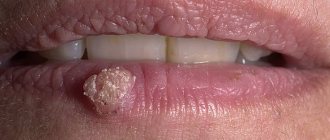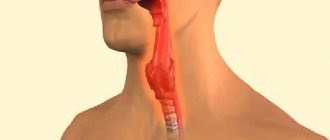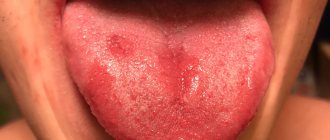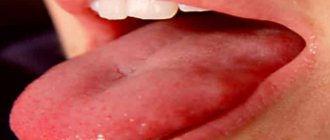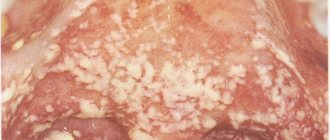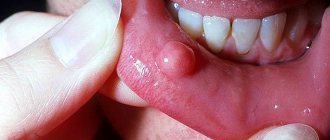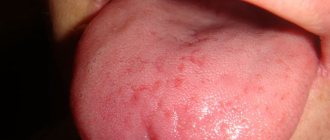Pathological changes in the oral cavity, as well as diseases of the oral mucosa are one of the symptoms of the presence of the immunodeficiency virus in the body. However, one should not think that the presence of dental problems may indicate infection with the immunodeficiency virus. To understand how oral diseases are related to HIV infection, it is worth talking in more detail about the immunodeficiency virus and its vital functions.
What is HIV? What is HIV infection
The human immunodeficiency virus, or HIV, was identified and described relatively recently. Invading the human body, it primarily affects macrophage cells and T-lymphocytes, which are responsible for recognizing and destroying hostile bacteria. Thus, the body's immune barrier loses its ability to resist both external bacterial attacks and internal opportunistic flora.
The immunodeficiency virus is transmitted exclusively through sexual contact or through direct contact of a healthy body with infected blood. Transmission of the virus through household or food contact is impossible.
HIV infection is a slow-onset disease caused by a virus and occurs against a background of suppressed immunity. It can take years from the introduction of the virus to the clinical manifestations of the disease. During this entire period, the virus does not manifest itself in any way, and its presence can only be diagnosed using a laboratory method.
Causes, routes of transmission of HIV
The main cause of HIV infection is infection with the HIV-1 or HIV-2 virus, which belongs to the retroviruses of the lentivirus subfamily. HIV-1 is most common in the USA, Russia, Central Africa and Europe; HIV-2 type is typical for West Africa and India. The only source of viruses is an infected person. Transmission of the disease is possible during any stage, including incubation.
The spread of infection is realized through natural and artificial transmission of the virus.
Natural route of transmission: sexual contact (hetero- and homosexual), transmission of the virus from mother to child during pregnancy, childbirth and breastfeeding.
Artificial route: exposures accompanied by disruption of the integrity of the skin and mucous membranes, contact with blood (injections using non-sterile instruments contaminated with blood, use of prohibited injection substances).
It is important to clarify whether HIV is transmitted through everyday contact: long-term studies over many years have proven that kissing, shaking hands, and sharing utensils and household items does not lead to infection. Source: HIV virology and pathogenetic mechanisms of infection: a brief overview. Emanuele Fanales-Belasio, Mariangela Raimondo, Barbara Suligoi, Stefano Buttò. Ann Ist Super Sanità 2010 | Vol. 46, No. 1:5-14. https://pubmed.ncbi.nlm.nih.gov/20348614/.
The largest number of infected people are in the age group from 20 to 45 years old; today more than 1.2 million infected people are registered in our country.
HIV infection of the oral cavity and its causes
Inflammatory processes in the mucous tissues of the oral cavity are one of the first symptoms of virus activation. This is due to the peculiarity of the structure of the oral cavity and its constant contact with the aggressive external environment. Most often, the mucous membrane is affected by the herpes simplex virus, Candida fungus, Epstein-Barr virus, and papillomaviruses. Bacterial infections are caused by streptococci and staphylococci, which are no longer contained by local immunity. In conditions of immunity suppressed by the virus, periods of remission become shorter, and inflammatory processes are acutely progressive. Timely prescribed additional studies make it possible to correctly prescribe a course of maintenance therapy, since diseases of the oral mucosa are not directly a symptom of HIV infection.
Based on their suspected association with HIV, oral infections are divided into three groups.
Group 1 includes pathologies most closely associated with the immunodeficiency virus:
- candidiasis, colloquially “thrush”;
- hairy leukoplakia (changes in the mucous membrane of the tongue);
- HIV gingivitis (acute inflammation of the gums);
- HIV periodontitis (periodontal inflammation);
- Kaposi's sarcoma (a specific neoplasm on the hard palate of the oral cavity);
- non-Hodgkin's lymphoma.
The 2nd group of diseases includes lesions to a lesser extent, associated with symptoms of HIV infection:
- thrombocytopenic purpura (multiple hemorrhages);
- pathology of the salivary glands;
- viral infections (herpes).
Group 3 includes diseases that often occur with HIV infection, but are not associated with it. Below we will consider diseases from the first group, as the most characteristic of the state of immunodeficiency.
Is it HIV?
Pavel, Moscow
March 2, 2019
Hello! I ask you to give an objective assessment: In mid-January, I had a relationship with a girl of easy virtue. On February 3rd I had another date with another girl. Both were protected, but in the first case the tip of the condom broke, and it is unknown how many contacts there were until we noticed (but not much). On February 4th (the day after the second session) folliculitis broke out in my groin area. On February 5th I was shivering at work. the temperature in the evening was 37.3. I found out on the Internet that it could be HIV. Accordingly, I began to feel my lymph nodes every half hour. in the evening after work I had a sore throat, it seemed that my submandibular lymph nodes were inflamed. the temperature did not drop. On February 6th, I no longer shivered and the sore throat disappeared, but the feeling of inflamed lymph nodes remained. On February 9th I went to the doctor, she prescribed an ointment for folliculitis. cured. but there are other ailments that do not go away to this day: temperature 37, the stomach is bubbling after eating, there is no gas formation, there have been loose stools only 4 times from the beginning of February to today (but it is bubbling all the time). There is a white coating on the tongue in the mouth, the tonsils are red, the palate is somewhat yellow, there is an ulcer under the tongue. There was a period when the tongue hurt, the taste sensations were not the same. it felt like there was sweet syrup in my mouth. On the night of February 27th, at some point I woke up with cold sweat coming from my forehead. On February 28th at 5 am, cold sweat also started coming from my forehead. On February 28th I went to the therapist, took a wedge blood test, urine test, test for HIV, syphilis, hepatitis C, chest x-ray and C-react. serum protein (result 4 mg/l). Everything is fine. The doctor examined my oral cavity, checked the lymph nodes, felt my stomach, said that everything was clean, she explained everything with stress. On March 1st at 1 am I woke up with cold sweat coming from my forehead. but there is no profuse sweating at night (during the night before). At some point it will work and then it stops. In the morning there was a white coating on my lips (for the first time) as if I had candidiasis. On March 2nd there was no cold sweat at night, in the morning the temperature was still 37, and I am attaching photographs of the oral cavity. yes, after my folliculitis came out and in the evening the temperature was 37.3, my throat hurt, I began to worry, in the first two weeks there was a lot of stress (until February 20th, say). but after that I calmed down a little. When I went to the therapist, I didn’t feel much stress. sometimes there are some strange impulses in the area of the submandibular lymph nodes (maybe I’m making this up). I understand that here I will not get an accurate diagnosis, since I need an in-person visit to the doctor. I ask you to give an objective assessment of what kind of illness this could be. Thank you!
The question is closed
low-grade fever
oral cavity
problems after eating
Symptoms of HIV infection in the oral cavity
The herpes simplex virus is present in most people. The infection persists in the body throughout life and does not cause any special problems, except for rare rashes on the lips.
Herpetic gingivostomatitis
In HIV-infected people, herpes rashes are chronic with rare stages of remission. It is distinguished by blistering rashes around the mouth and on mucous tissues. When the vesicles open, painful erosions occur that develop into fairly large ulcers. The manifestation of herpes zoster and rashes in atypical places is also noticed.
Candidiasis
Candidiasis is also a common symptom of HIV infection and is chronic. Its symptoms are the same as with regular thrush, the only difference being that plaque covers most of the mouth.
Hairy leukoplakia
Clinical manifestations of the disease look like deformed mucous tissue, externally resembling folds or hairs. Localization area: lateral parts of the tongue and the inner surface of the cheeks. Painful sensations are usually absent.
HIV gingivitis and periodontitis
In this case, the infection manifests itself as acute inflammation of the gums. Starting with ordinary bleeding gums, the disease quickly develops into an acute form. With adequate treatment, tooth loss can be avoided.
Kaposi's sarcoma
This is one of the most characteristic symptoms of HIV infection in the clinical stage of manifestation. The tumor is formed from lymphatic vessels, in the mouth it is located near the root of the tongue, less often on the gums.
Candidiasis in HIV-infected prisoners
Tertyshnikova V.V.
Kuban State Medical University, Department of Infectious Diseases and Epidemiology, Physics and Practice, Krasnodar
Candidiasis (synonyms: candidiasis, candidiasis) is a disease caused by yeast-like fungi of the genus Candida. In addition to relatively benign candidiasis of the mucous membranes and skin, severe visceral forms of mycosis are possible, often with predominant damage to the gastrointestinal tract and respiratory organs. These forms developed especially often in HIV-infected individuals.
Under our supervision there were 150 convicted women with HIV infection, in stage 3B - 87 patients, 3B - 43 women, 4A - 8 prisoners, 4B - 4 and 4B - 8 prisoners (according to V.I. Pokrovsky’s classification). During the examination of patients, candidiasis was detected in 138 patients, including candidiasis of the oral cavity and genitourinary organs - in 86 women, in 44 candida were isolated in sputum, from the oral mucosa, and in all of them, immunoglobulins of the Ig G class to the genus Candida albicans were detected by enzyme immunoassay. The degree of fungal growth at stage 3B was 2.8 ± 0.84, at stage 3B – 3.2 ± 0.86.
Candidiasis of the oral mucosa (thrush) manifested itself in HIV-infected patients in the form of white plaques (solid or isolated areas) on the mucous membrane of the cheeks, the back wall of the pharynx, and on the tongue. The affected areas were usually painless, but when plaque thickened and cracks formed, mild pain in the oral cavity occurred.
With chronic mucocutaneous candidiasis, HIV-infected people developed lesions in the form of hyperkeratosis, nail damage, alopecia areata in combination with long-term changes in the mucous membranes. Deeper lesions of the mucous membranes (which is often observed in disseminated forms) manifested themselves in extensive changes in which the plaque spread to the mucous membranes of the esophagus, stomach, trachea, and bronchi. This was accompanied by difficulty swallowing and chest pain.
In individuals with HIV infection (45 convicted women), hematogenously disseminated forms of candidiasis (candidal sepsis) were recorded, characterized by a severe course, high fever and severe symptoms of general intoxication. Fever of the wrong type with repeated chills interspersed with profuse sweating. Accompanied by damage to various organs (lungs, gastrointestinal tract, brain, kidneys, etc.). The presence of several foci of lesions is typical. Hematogenous lung damage was characterized by the development of infiltrates. The patients were bothered by a strong cough, initially dry, then with a small amount of viscous mucopurulent sputum, sometimes streaked with blood. X-ray examination revealed infiltrates, often in the lower lobes, prone to fusion; decay with the formation of cavities was often observed. In case of secondary pulmonary candidiasis in HIV-infected people (against the background of pneumonia, tuberculosis), changes in clinical symptoms (deterioration in general condition, appearance of hectic fever, etc.) were recorded.
Diagnosis and differential diagnosis. Isolation of a culture from sputum, throat mucus, feces, smears and scrapings from affected mucous membranes, skin, and nails cannot serve as evidence of disseminated (visceral) candidiasis. Isolation of a culture from blood, cerebrospinal fluid, intra-articular fluid or in biopsied tissues had diagnostic significance. When the skin and mucous membranes were affected, a large number of candida were detected (by microscopy) in sputum, feces, and throat mucus, and fairly high titers of antibodies were detected in RSC and agglutination reactions with a specific antigen. High titers (1:160–1:1600) or an increase in antibody titers during the course of the disease were considered positive.
Treatment. For lesions of the mucous membranes (oral, vaginal candidiasis), a suspension containing nystatin was used locally. For damage to the mucous membrane of the esophagus, ketoconazole (Ketoconazole) 200-400 mg per day was used (effectiveness about 50%), if the symptoms of damage to the esophagus did not disappear within 5-10 days, then Diflucan (fluconazole) was used. It is prescribed orally at 100 mg per day for two days (about 90% effective). In these cases, intravenous amphotericin B 0.3 mg/kg was also used.
For disseminated (systemic, visceral) candidiasis, amphotericin B was used; it was prescribed intravenously in a 5% solution in the form of drip infusions at the rate of 250 U/kg body weight (0.3 mg/kg), the course of treatment took several weeks.
An effective drug for the treatment of systemic candidiasis was Diflucan, which was prescribed orally at a dose of 200 mg per day for two days. Adverse reactions were observed relatively rarely (2-4%) in the form of nausea, diarrhea, and headache. ‹ On the issue of latent syphilisUp Classification of scars ›
Diagnosis for suspected HIV infection
For differentiated diagnosis of HIV infection from similar dental diseases, the following tests are used:
- Blood test for PCR reaction (aimed at detecting HIV).
- Immunoblotting technique.
- Linked immunosorbent assay.
- Checking immune status.
If the results are unclear, additional blood tests, as well as bacteriological studies, may be prescribed. Early diagnosis of the root cause of diseases can significantly alleviate the course of the disease.
Prevention
There is no vaccine or effective preventive medication against HIV. Therefore, prevention consists of following simple safety measures:
- it is necessary to practice only safe sex (with a condom, a trusted sexual partner);
- for various manipulations, it is important to use only sterile instruments;
- annual HIV testing is important;
- mandatory examination before planning pregnancy, during registration and before childbirth.
Sources:
- HIV infection: issues of therapy. Aronin Steve I. Kazan Medical Journal No. 6, 2005. p. 433-450
- The impact of HIV infection on the quality of life of people living with HIV/AIDS. Tursunov R.A. Avicenna Bulletin No. 1, 2013. pp. 138-148
- Prevalence of HIV infection in Russia. Pirogova I.A. Bulletin of the Council of Young Scientists and Specialists of the Chelyabinsk Region No. 4, 2017
- Structural biology of HIV. B. G. Turner, M. F. Summers. Howard Hughes Medical Institute and Department of Chemistry and Biochemistry University of Maryland Baltimore County. https://www.sciencedirect.com/science/article/abs/pii/S0022283698923543?via%3Dihub
- HIV virology and pathogenetic mechanisms of infection: a brief overview. Emanuele Fanales-Belasio, Mariangela Raimondo, Barbara Suligoi, Stefano Buttò. Ann Ist Super Sanità 2010 | Vol. 46, No. 1:5-14. https://pubmed.ncbi.nlm.nih.gov/20348614/
- Molecular epidemiology of HIV. AJ Kandathil, S Ramalingam, R Kannangai, Shoba David, G Sridharan. Indian J Med Res 2005 Apr;121(4):333-44. https://pubmed.ncbi.nlm.nih.gov/15817947/
Localization and types of warts on the tongue
The most common location for benign tumors in the mouth is the front of the tongue. Especially often, atypical growth of epidermal cells of the mucous membrane is observed at the tip of the tongue and along its lateral parts. In rare cases, warts may cover the entire dorsal surface of the organ. Papillomas almost never form on the root of the tongue.
Warts on the tongue can be represented by one of two types of neoplasms:
- Flat warts. They are a bright pink or reddish papule that has a dense, hard consistency.
- Pointed warts (condylomas). Visually similar to pale epidermal papillae. As they grow, condylomas often merge, forming lobular growths that resemble cauliflower. Genital warts are most often localized under the tongue.

